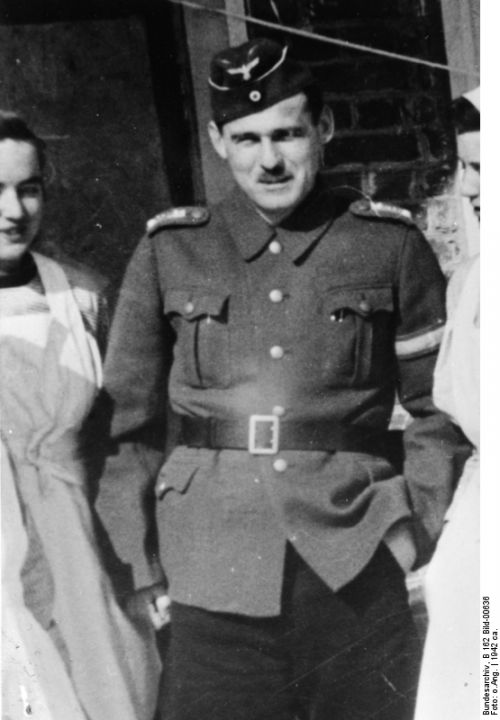Bernburg

Dr. Irmfried Eberl (Bundesarchiv)
A mental home with a capacity of 132 beds was founded in 1875, in Bernburg, near Magdeburg, As a replacement for Brandenburg an der Havel, in September 1940, a section of the complex was appropriated by the Charitable Foundation for Institutional Care, one of the fake organisations set up to camouflage the euthanasia programme, more commonly known as 'Aktion T4.' From that time onwards Bernburg mental home was divided into both a normal institution and a euthanasia killing centre.
Within four weeks during October and November 1940, eighty square metres of the cellar in the former 'Mannerhaus 2' were converted into a killing facility. The staff from Brandenburg -an -der Havel, including physician-in-chief Dr. Irmfried Eberl, moved as a group to the new killing centre at Bernburg. Dr Eberl later became the first commandant of the Treblinka death camp in Poland.
A small room for the gas chamber, was disguised as a shower room, was equipped with a peephole and the walls and floor was tiled. In this gas chamber, measuring fourteen square metres, 8,601 people were murdered during the 'Aktion T4.' Another room was converted into a crematorium by installing two crematory ovens, with a third room utilised as a dissecting room, and a fourth room as a mortuary.
The murders began on November 21, 1940, with 25 people from the mental home at Neurippen, which served as an Intermediate Home. The extermination process at Bernburg was the same as in the other T4 euthanasia killing centres. The victims were first registered, then required to undress and hand over any valuables in their possession.
Generally large grey buses brought the victims to Bernburg, although some patients arrived by train. After examinations, in one of the ground floor rooms, the victims were photographed and were then ushered to the basement in groups of between 60 and 75, accompanied by nurses. Those having distinctive physical features were marked with a red cross on their back by doctors. After gassing took place the two gas chamber doors remained closed for one hour, until the room had been ventilated. Adjoining the gas chamber there was the dissection room. After gassing the corpses bearing the red cross were separated and then subjected to an autopsy. The other bodies were cremated immediately by the stokers or 'burners',' as they were known in T4 circles. Once cremated, urns were filled with ashes. No attempt was made to identify specific remains. Finally the urn containing a quantity of ashes, together with a falsified death certificate was forwarded to the next of kin.
Franz Stangl, who later was to be commandant at Sobibor and Treblinka death camps in Poland, recalled in a conversation with Gitta Sereny: ' I had to look after property rights, insurance and that sort of thing. After all, some of those who died left children who had to be properly provided for. Bernburg was a mess.'
Under the Sonderbehandlung 14f13 Aktion, approximately 5,000 people were killed in Bernburg between 1941, and April 1943. In the main these were Jews from the concentration camps, Buchenwald, Flossenburg, Gros-Rosen, Neuengamme, Ravensbruck and Sachsenhausen. One example of how the process worked, might be useful: On January 19-20, 1942, two-hundred and fourteen prisoners were selected at Gros-Rosen and their questionnaires were sent to the T4 headquarters in Berlin, who then transmitted the list of selected prisoners to Bernburg. On March 3, 1942, Bernburg requested the transfer of two-hundred and fourteen prisoners. On March 6, 1942, Gros-Rosen authorities replied that the one -hundred and twenty five who remained would be transferred on March 23, - the other prisoners originally selected by them had either died or were now deemed capable of working.
The buildings not occupied by T4 continued to operate as a normal mental institution throughout the entire T4 and 14f13 murder programmes. Following an order from the WVHA on April 27, 1943, the crematory ovens were dismantled and the T4 personnel transferred to Poland. A number of senior figures in the Aktion Reinhardt mass murder programme served at Bernburg, and these included were: Max Biela, Dr. Irmfried Eberl, Karl Frenzel, Gottlieb Hering, Gottfried Schwarz, Franz Stangl, and Christian Wirth.
Dr. Irmfried Eberl was arrested by American troops in April 1945, but he evaded trial by committing suicide in his cell at the Ulm Remand Prison in February 1948. The Director of Bernburg Willi Enke, was arrested but no further charges were brought after November 1945. During 1948, another trial took place in Magdeburg and Josef Oberhauser, was sentenced to fifteen years in prison, for euthanasia crimes. Dr Bunke, 'Totungsarzt' stood trial in 1966 and 1987. Dr. Bunke was sentenced to four years in prison for accessory to murder in 1987. However, the Federal Court reduced the sentence to three years, because there was only evidence that he assisted in the murder of 9,200 people.
In September 1989, the Bernburg Memorial was inaugurated.
Sources
Friedlander, Henry. The Origins of Nazi Genocide: From Euthanasia to the Final Solution, University of North Carolina Press, Chapel Hill, 1995.
Sereny, Gitta, Into the Darkness, Pimlico, London, 1974.
www. Holocaustresearchproject.org - online resource
Tiergartenstrasse4Association, Berlin
Thanks to Robert Parzer, Co-Founder of the EU Project Gedenkort T4 eu
https://www.gedenkort-t4.eu/en
Photograph: Bundesarchiv
© Holocaust Historical Society 2018

